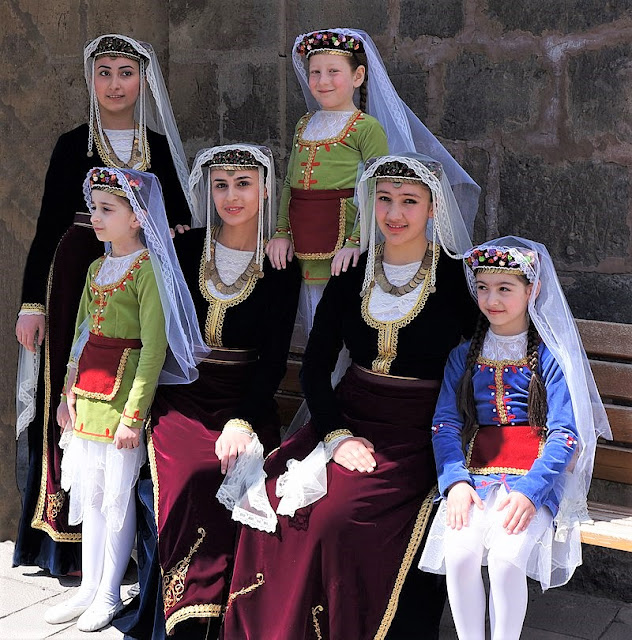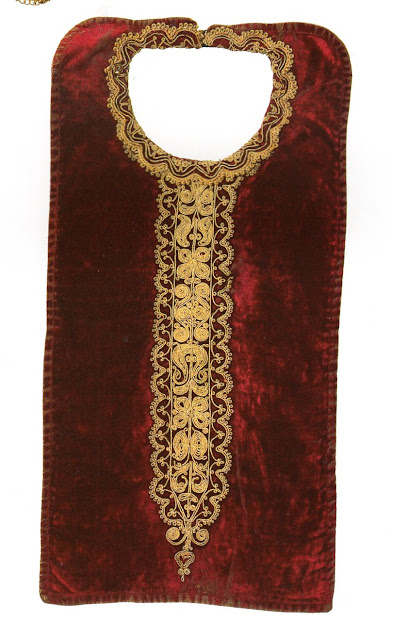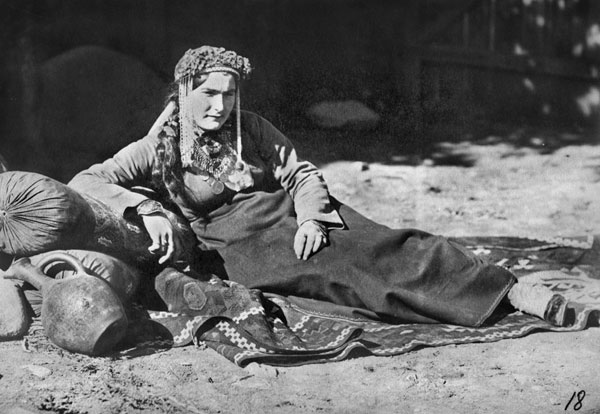Hello all,
Today I wish to talk about one particular Armenian Costume. Armenian costumes have been understudied, and I feel that I have insufficient information on them. There was a classic study published by Arakel Patrik in 1967 and not much since. Most of the publications since then are a rehash of the same material, with mostly unsuccessful attempts at reconstruction. Someone, preferably with a knowledge of the language should undertake a collection of museum pieces which are scattered over a number of countries, collate and publish the results.
The Armenians, or Hayer, had a kingdom which was flourishing at the time of Christ. More recently, they have had the misfortune of being right on the front lines of a centuries long conflict between three Empires, Persia, Russia, and the Ottomans. The Persians and the Turks felt that the Armenians [and Greeks] could not really be trusted, as they were Christian. The Russians felt the same about Moslem groups on their side of the border. There were many migrations and displacements, ending in the mass genocide and expulsion of Armenians from Western Armenia, which now lies within Turkey, in the early 20th cent. The current State of Armenia is a corner of original Armenian territory, and even today, more Armenians live outside of the State of Armenia than within it.
Akhaltsikhe, or Samtskhe-Javakheti, is a region in Georgia which borders Armenia on the north. This area always had some Armenians, but in 1829 a number of Armenians migrated here when the Russian Empire took over the region. At the same time, numbers of Adjars and Meshkhetians migrated the other way. Many of these Armenians came from Karin [Erzurum], and brought their costume with them. This costume flourished in this region, in which over half of the inhabitants are Armenian. This costume was also worn in the area of Kars, including Artvin.
The photo above shows a modern interpretation of this costume, with ridiculously abbreviated skirts on the little girls.
Here is a sketch of the original costume of Karin. This costume was a popular subject for photographers.
It was also the subject of one of the first color photographs by Prokudin Gorsky circa 1913.
This is a rich and expensive costume.
First, a pair of bloomers, usually made of striped material is put on.
Over this, a full length chemise is worn. When fully dressed, the only part that shows is the front, which is left uncovered by the neck opening of the overdress. This garment helps the fullness of the skirt and keeps the overdress from sticking to the legs. Here is an example of a chemise from Yerevan. The one worn in this region would be similar, although it would have a stand-up collar.For more dress occasions, a kaftan of striped silk would be worn over the chemise. The extra long slit sleeves would hang out past the sleeves of the overdress. This drawing shows the kaftan, and also the cap and slippers for this costume.
Most of the time the kaftan did not show at the neckline, but take a look at this photo.
Here is an exhibit in a Russian museum, where you can see the kaftan opening within the opening of the overdress. In fact, there seem to be two layers.
The overdress was very full, and was usually made of blue or violet velvet. Other colors and materials were also used. It did not have set in sleeves, which is a modern invention.
The cuffs, neck opening and hem were usually ornamented with couched gold braid.
Some old photographs clearly show other materials being used. Here the girl on the left has an overdress of floral brocade, the one in the middle used a striped silk, and the older woman on the right has an overdress which does not have decolletage in front, but fastens closed with some ornamentation at the center line. Note that she has her hair covered under her headdress with a scarf or veil, and her attire is simpler. This accords with her age and being married. The floral brocade kaftan of the girl in the middle is also visible at the neckline.
This is an especially rich form of the costume and obviously was only worn by the wealthy for special occasions. Here are a couple of examples of this type of dress from a Museum in Yerevan. Both of these are from Karin.
This example is from Olti in the Kars region.
As is this one.
This example is from Akhaltsikhe.
Some old photographs clearly show other materials being used. Here the girl on the left has an overdress of floral brocade, the one in the middle used a striped silk, and the older woman on the right has an overdress which does not have decolletage in front, but fastens closed with some ornamentation at the center line. Note that she has her hair covered under her headdress with a scarf or veil, and her attire is simpler. This accords with her age and being married. The floral brocade kaftan of the girl in the middle is also visible at the neckline.
Here we see an older woman wearing an overdress very similar to that of the girl on the left above. She is in dress attire, yet her cap is simpler, and she is wearing a scarf wrapped around her head instead of a veil, as befits her age and marital status.
This woman, on the other hand, is wearing an especially elaborate overdress with gold couching all over. It is clear that the front of the overdress is not sewn shut, but gaps in front, except for a wide band at the waist. She has also dispensed with the apron. She also has an especially ornate underdress and a matching jacket. Two undergarments have extra long sleeves dangling from the wrists.
This is an especially rich form of the costume and obviously was only worn by the wealthy for special occasions. Here are a couple of examples of this type of dress from a Museum in Yerevan. Both of these are from Karin.
Usually this costume is worn with an apron. The dress apron was usually some shade of red. Simpler ones had a line of thin gold braid around the edge. Fancier ones had a band of gold couching, and the most elaborate had an additional paisley type motif in the corners. Take another look at the photos in this article.
Especially elaborate aprons had a scalloped edge.
Sometimes, as here, there seem to be initials in the paisley motif.
Here is a photograph of an older woman from Kars district wearing a very plain version of this outfit. Note that her hair is compeletly covered.
A narrow woven sash in red and yellow was worn around the waist over the apron. See above.
For dress occasions, sometimes a velvet dickey with gold embroidery would be worn to cover up the chemise within the neckhole of the overdress, like this example from Akhaltsalikhe.
For dress, elaborate jewelry was worn with this outfit, most commonly intricately made necklaces.
First is a red cap, with a tassel connected by a metal fixture. then two side pieces with dangling ornaments, a band with coins attached to the edge, another band with beads worn at its upper edge, and finally, a cloth band, Vard, worn over the top. Over this a veil is often fastened. Armenian needlelace is very famous. Here we see the cap, tassel, and cloth band.
If we look at the cloth band, there are two large button like shapes which are worn at the sides of the forehead. Originally, this was covered by flowers made with Armenian needlelace.
Today, most opt for simpler solutions, as creating these lace flowers takes great skill and much time. One example is to cut out tiny shapes from felt.
Or use commercially available artificial silk flowers.
Here are a couple of these bands embroidered with different techniques.
Take a look at the variations in the various photographs.
Here is another exhibit in a Russian museum.
In this example the forehead band has ornaments of gold filigree, the overdress is made of a red brocade with gold woven design, and a jacket is worn over the top. The jacket is of blue velvet and has the gold couchwork that one would normally see on the overdress.
Here is a photograph of another such a jacket, from Karin.
An old colorized postcard. The colors were filled in at random.
The following are various modern reconstruction attempts.
Thank you for reading, I hope that you have found this to be interesting and informative.
Roman K
email: rkozakand@aol.com
Source Material:
Alexandrian Garinee, 'Album of Armenian Costumes', Beirut, 1980
Anoush Chamlian et al, 'Armenian Costume Through the Centuries', Fresno
Arakel Patrik et al, 'Armenian Costumes from Ancient Times to the Present Day',
Yerevan 1967
Alice Odian Kasparian, 'Armenian Needlelace and Embroidery', McLean Va 1983
Khajak ter Grigorian, 'Armenian Traditional Costumes', Isfahan 2000
Gregory Lima et al, 'The Costumes of Armenian Women', Tehran 1974
Max Tilke, 'Costume Patterns and Designs', Tuebingen, 1926, reprinted in New York, 1990
Natalia Kalashnikova et al, 'National Costumes of the Soviet Peoples', Moscow, 1990
Martha Longenecker et al, ' Folk Art of the Soviet Union', San Diego, 1989
Tatyana Razina et al,'Folk Art in the Soviet Union', Leningrad-New York, 1990
Robert Allshouse, 'Photographs for the Tsar - The Pioneering Color Photographs of Sergei Mikhailovich Prokudin-Gorskii', New York, 1980
Sophia Avizhanskaya, 'Museum of the Ethnography of the Peoples of the USSR', Leningrad, 1990
Anelka Grigoryan, 'Armenian Costume 18th-19th Centuries', Yerevan, 2014











































































































Dear Roman: Thank you for finding this much detail about this particular area. I find the gold work on the aprons particularly inspiring, with lots of subtle details to explore. And the needlelace "buttons" on the head dress are wonderful. I'm picking up needle and thread again to attempt to create my own flowers - very hard work indeed.
ReplyDeleteIt would be very good if someone will begin a real study, as you suggest. We will all benefit from the results.
Sincerely, Charlotte in California
Thank you Roman for posting these pictures and including explanations regarding the various under-garments, over garments and accessories of Armenian traditional costumes.
ReplyDeleteVery informative and impressive post you have written, this is quite interesting and I have gone through it completely, an upgraded information is shared, keep sharing such valuable information. Find the best dance costume
ReplyDeleteThanks for sharing this amazing and informative post. keep sharing with us.
ReplyDeletewestern leather jackets for men
I like looking through an article that can make men and women think. Also, thank you for permitting me to comment!Beth Dutton Blue Jacket
ReplyDeleteThanks for the article, its really very useful.
ReplyDeleteWomen's Gothic Pant's
Great post I really liked it. Great respect for the author. It is very interesting. Star Trek Picard Leather Jacket
ReplyDeleteWhat an awesome idea! This is such a practical gift! I love it!
ReplyDeleteMen Gothic Jacket
That really nice to see that world is moving onward with the improvements in different sectors.
ReplyDeleteDamascus Hunting Knife
Great costume....Lovely process..
ReplyDeletetable fans
Huge crowd in yoga classes! I have never seen it before. Many thanks for sharing this wonderful post
ReplyDeleteALL THANKS TO DR WILLIAMS WITH HIS HERBAL PORTION I WAS COMPLET경산출장샵ELY CURED FROM BREAST CANCER.
ReplyDeleteYou were great and everyone received so much from your experience and knowledge
ReplyDeleteAbsolutely amazing, thank you for sharing your knowledge with me.
ReplyDeleteYou always comes with great stuff for your user.
ReplyDeleteKeep posting such great stuff
ReplyDeleteThanks for all the tips mentioned in this article!
ReplyDeleteThanks for posting this info. I just want to let you know that I just check out your site
ReplyDeleteArmenian costumes are so beautiful!!!!!!
ReplyDeleteArmenia has got a special place in my heart.
ReplyDeleteI want an Armenia folk costume so badly!!!!!
ReplyDelete